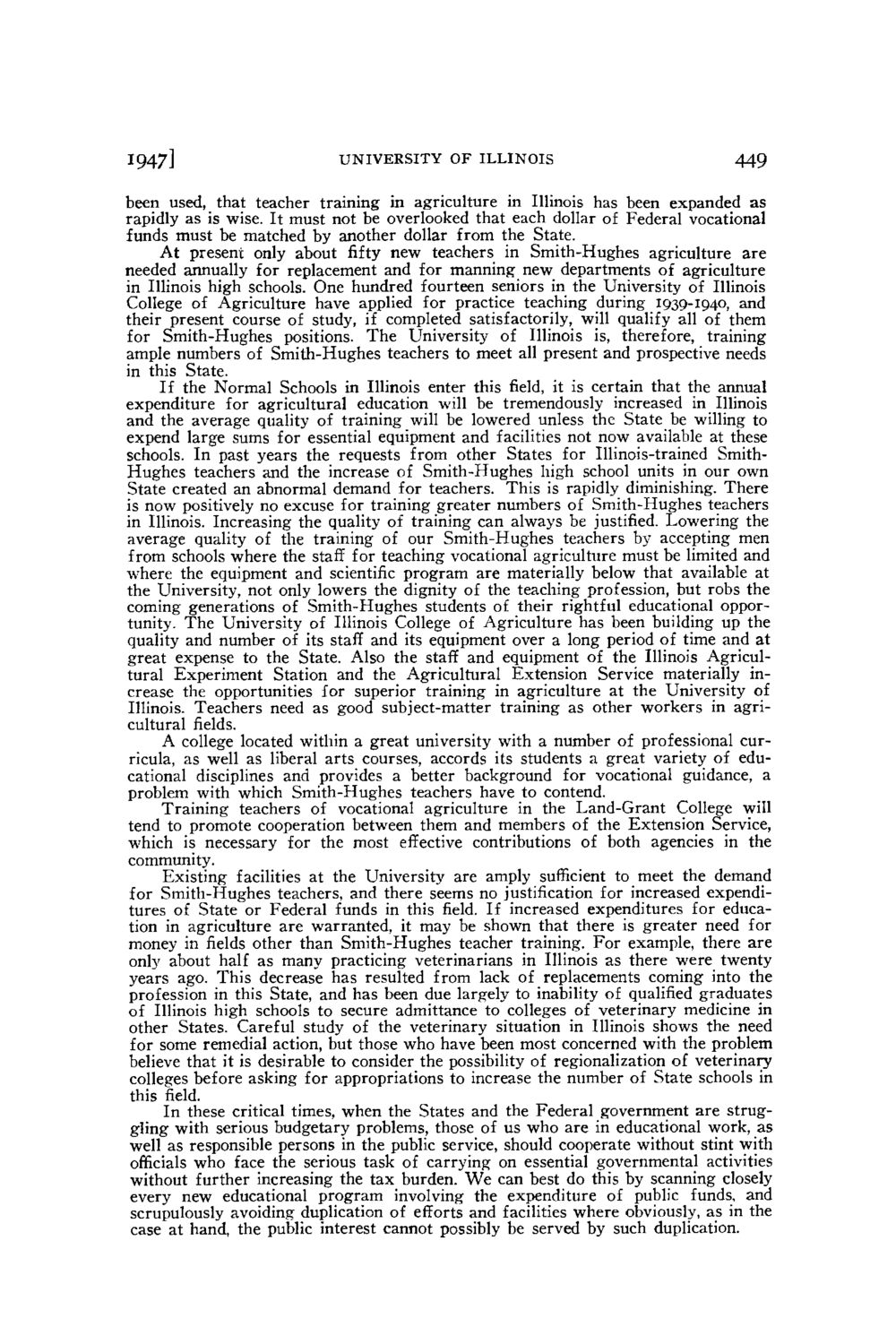| |
| |
Caption: Board of Trustees Minutes - 1948
This is a reduced-resolution page image for fast online browsing.

EXTRACTED TEXT FROM PAGE:
1947] UNIVERSITY OF ILLINOIS 449 been used, that teacher training in agriculture in Illinois has been expanded as rapidly as is wise. It must not be overlooked that each dollar of Federal vocational funds must be matched by another dollar from the State. At present only about fifty new teachers in Smith-Hughes agriculture are needed annually for replacement and for manning new departments of agriculture in Illinois high schools. One hundred fourteen seniors in the University of Illinois College of Agriculture have applied for practice teaching during 1939-1940, and their present course of study, if completed satisfactorily, will qualify all of them for Smith-Hughes positions. The University of Illinois is, therefore, training ample numbers of Smith-Hughes teachers to meet all present and prospective needs in this State. If the Normal Schools in Illinois enter this field, it is certain that the annual expenditure for agricultural education will be tremendously increased in Illinois and the average quality of training will be lowered unless the State be willing to expend large sums for essential equipment and facilities not now available at these schools. In past years the requests from other States for Illinois-trained SmithHughes teachers and the increase of Smith-Hughes high school units in our own State created an abnormal demand for teachers. This is rapidly diminishing. There is now positively no excuse for training greater numbers of Smith-Hughes teachers in Illinois. Increasing the quality of training can always be justified. Lowering the average quality of the training of our Smith-Hughes teachers by accepting men from schools where the staff for teaching vocational agriculture must be limited and where the equipment and scientific program are materially below that available at the University, not only lowers the dignity of the teaching profession, but robs the coming generations of Smith-Hughes students of their rightful educational opportunity. The University of Illinois College of Agriculture has been building up the quality and number of its staff and its equipment over a long period of time and at great expense to the State. Also the staff and equipment of the Illinois Agricultural Experiment Station and the Agricultural Extension Service materially increase the opportunities for superior training in agriculture at the University of Illinois. Teachers need as good subject-matter training as other workers in agricultural fields. A college located within a great university with a number of professional curricula, as well as liberal arts courses, accords its students a great variety of educational disciplines and provides a better background for vocational guidance, a problem with which Smith-Hughes teachers have to contend. Training teachers of vocational agriculture in the Land-Grant College will tend to promote cooperation between them and members of the Extension Service, which is necessary for the most effective contributions of both agencies in the community. Existing facilities at the University are amply sufficient to meet the demand for Smith-Hughes teachers, and there seems no justification for increased expenditures of State or Federal funds in this field. If increased expenditures for education in agriculture are warranted, it may be shown that there is greater need for money in fields other than Smith-Hughes teacher training. For example, there are only about half as many practicing veterinarians in Illinois as there were twenty years ago. This decrease has resulted from lack of replacements coming into the profession in this State, and has been due largely to inability of qualified graduates of Illinois high schools to secure admittance to colleges of veterinary medicine in other States. Careful study of the veterinary situation in Illinois shows the need for some remedial action, but those who have been most concerned with the problem believe that it is desirable to consider the possibility of regionalization of veterinary colleges before asking for appropriations to increase the number of State schools in this field. In these critical times, when the States and the Federal government are struggling with serious budgetary problems, those of us who are in educational work, as well as responsible persons in the public service, should cooperate without stint with officials who face the serious task of carrying on essential governmental activities without further increasing the tax burden. W e can best do this by scanning closely every new educational program involving the expenditure of public funds, and scrupulously avoiding duplication of efforts and facilities where obviously, as in the case at hand, the public interest cannot possibly be served by such duplication.
| |